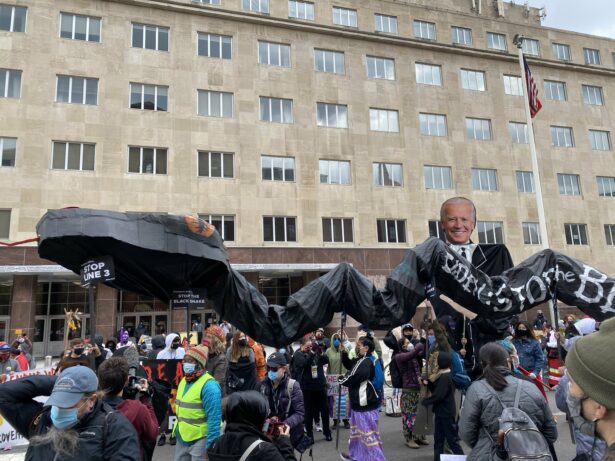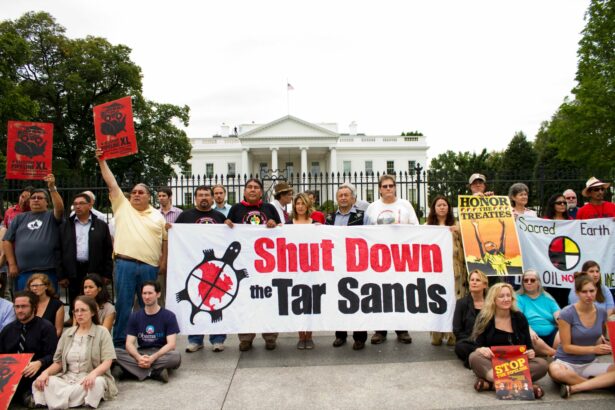Hundreds of people rallied in front of the U.S. Army Corps of Engineers headquarters in Washington, D.C. on April 1 to deliver 400,000 petition signatures calling on the Biden administration to stop a pair of major oil pipelines threatening Indigenous nations’ land and water.
“We as Indigenous people are done being silenced,” Cadee Peltier, a 16-year-old member of the Standing Rock Sioux Tribe and Turtle Mountain Band of Chippewas, told the crowd. “We will not allow our sacred lands and waterways to continue to be desecrated.”
One of the projects in question, the Dakota Access pipeline, runs from North Dakota’s Bakken oil fields to Illinois, crossing under a Missouri River aquifer just outside the Standing Rock Reservation’s northern boundary. Controversy has surrounded this pipeline since before construction began in 2016, partly because of the potential for a catastrophic oil leak that would pollute the Missouri and jeopardize Standing Rock’s water supply.
Previous Coverage
 Indigenous-led resistance to Enbridge’s Line 3 pipeline threatens Big Oil’s last stand
Indigenous-led resistance to Enbridge’s Line 3 pipeline threatens Big Oil’s last standYouth from Standing Rock and the neighboring Cheyenne River Sioux Reservation, most in their teens and early 20s, organized a 2,000-mile relay run to D.C. for last week’s petition delivery, ahead of an April 9 court hearing on whether Dakota Access should be shut down while a new environmental review is completed. Along the way, some of the runners connected with Indigenous organizers from Anishinaabe lands in Wisconsin, where construction of the Line 3 pipeline is ongoing. For the past few months, Anishinaabe water protectors have sat in trees and chained themselves to equipment to halt work on Line 3, which is intended to carry oil from the Canadian tar sands into the United States.
Peltier was one of many Indigenous youth and other pipeline opponents who spoke outside Army Corps headquarters, addressing a mixed crowd of Native pipeline resisters, climate activists and members of allied movements like Black Lives Matter. Some had been to many similar actions before, and at times the event seemed to represent a passing of the torch to a new generation of activists.
“We have stood where you have stood,” Jasilyn Charger of the Cheyenne River Sioux, now in her mid-20s, told runners even younger than herself. Five years ago, Charger was part of a group of Indigenous youth who organized a similar relay run as the fight against Dakota Access was taking off in earnest. “Know you are not alone,” she now said. “We are going to be beside you every step of the way.”
Adding to the sense of continuity with the past was a theatrical prop created by young Standing Rock tribal members for the rally: a giant black snake puppet over 300 feet long, supported on poles carried by activists. For more than a decade, Indigenous pipeline fighters on Lakota Sioux territory have related their struggle to an ancient prophecy that a terrifying black snake would one day threaten life on Earth. This imagery was important early in the campaign to stop Keystone XL, a tar sands pipeline that would have crossed near the southern boundary of the Cheyenne River Sioux Reservation. Today the symbolism of the black snake is widely used by water protectors fighting projects like Dakota Access and Line 3.

The work of Charger, Peltier and others has already stopped at least one black snake. On his first day in office, President Biden overturned the permit for Keystone XL, putting a cap on the years-long campaign to stop that project. With the April 1 action, Indigenous organizers signaled they won’t stop until other, equally destructive pipelines are halted as well — and that Biden can’t escape a movement that has already spanned two presidential administrations and more than a decade of pipeline resistance.
From Keystone XL to Dakota Access and Line 3
Joseph White Eyes was in his early 20s, and already a seasoned pipeline fighter, when elders from Standing Rock convened a meeting to discuss resisting the then-proposed Dakota Access pipeline at the beginning of 2016. A member of the Cheyenne River Sioux Tribe, White Eyes had attended nonviolent direct action trainings organized by groups like the Indigenous Environmental Network and Owe Aku International Justice Project, which were intended to prepare for direct action against Keystone XL. This got him thinking about other pipelines.
“All the while we were fighting Keystone XL, I kept hearing about how Dakota Access would affect Standing Rock to the north,” White Eyes said. “In the back of my head I wondered, who was going stop that pipeline? But I assumed someone from up there would figure it out.”
Previous Coverage
 Overwhelming odds, unexpected alliances and tough losses — how defeating Keystone XL built a bolder, savvier climate movement
Overwhelming odds, unexpected alliances and tough losses — how defeating Keystone XL built a bolder, savvier climate movementIn December 2015, the Army Corps of Engineers determined running Dakota Access under the Missouri River would result in no significant environmental impact, a claim disputed by tribal members and environmental groups. Standing Rock elders called a meeting to discuss an organized response. Joye Braun, a Cheyenne River Sioux organizer who mentored many younger activists during the Keystone XL fight, reached out to White Eyes and others who’d been preparing to resist that pipeline with civil disobedience. At the time, Keystone XL was on pause, having been recently rejected by the Obama administration after years of public pressure.
“We ended up borrowing my grandmother’s vehicle, and about 10 of us caravanned up to Standing Rock to participate in the meeting about stopping Dakota Access,” White Eyes said.
Out of that gathering was born the Sacred Stone Camp which Braun, White Eyes, and other Cheyenne River and Standing Rock tribal members set up near the pipeline construction zone to serve as a hub for direct action resistance. The encampment started with a small group of people pitching their tents that April, and within months grew to epic proportions — drawing worldwide media attention.
A key moment contributing to this meteoric growth came early on, when White Eyes and other youth from the two tribes organized a 500-mile relay run from Sacred Stone to the regional Army Corps office in Omaha, Nebraska. They met with Indigenous leaders and youth whose land they passed through along the way, using social media to document the run. The effort was successful enough that they decided to follow it up with a similar, longer journey that summer. In July, a group of youth departed Sacred Stone on a 2,000-mile run to the Army Corps’ national headquarters in Washington, D.C., where they secured a meeting with a Corps general.
“We requested it be just young people who participated in the meeting,” White Eyes said. “We went around the room and talked about why we joined the run and why we wanted this pipeline stopped.” The federal government’s response was underwhelming, though. “It seemed like none of them were really interested in what we had to say.”
Days before the youth arrived in D.C., the Army Corps had given its approval to start building Dakota Access under the Missouri River. But although the runners couldn’t convince the Obama administration to reverse this decision, their efforts decisively changed the terms of public debate over the pipeline. Partly, this was due to the way they used photos and video to tell their story online.

“It was hard,” said Morgan Brings Plenty, who recorded moments from the run, collated them and posted the footage on social media. “We relied on two phones that were barely working to upload content. I had to work as fast as I could, getting as much material online as possible.”
Videos where young runners explained what was at stake at Standing Rock went viral, catching viewers’ imaginations. By the time the youth returned to Sacred Stone, the camp had grown from around a dozen people to hundreds. The next couple months saw thousands more join, including members of other tribes who wanted to show solidarity and climate activists concerned about oil. New encampments split off from Sacred Stone, and at the height of the protests some 10,000 people pitched their tents near the Missouri.
Police eventually cracked down on the Standing Rock protests with attack dogs and chemical weapons, but the use of violent force backfired. Public outcry over the treatment of protesters helped finally convince the Obama administration to reject a final permit needed by Dakota Access in December 2016. However, one of the first acts of the new Trump administration was to re-issue it. Construction resumed and Dakota Access began pumping oil that spring.
Other pipelines also moved forward under the oil-friendly administration. The Trump State Department re-started the review process for Keystone XL. Meanwhile, a fight with equally serious implications for the climate and Indigenous rights was heating up to the east. Although promoted by builder Enbridge as the “replacement” for an existing pipeline, Line 3 would increase the volume of tar sands oil transported through Minnesota while using a new route that roughly parallels the boundary of the White Earth Reservation.
In late 2020, the Army Corps of Engineers and Minnesota Pollution Control Agency issued permits allowing work on Line 3 to start. COVID safety considerations made organizing a direct action response on the scale of what happened at Standing Rock difficult. Even so, tractors and tree-fellers beginning construction along the pipeline route have been met with sustained human blockades.
When the new Biden administration took office, it presented both fresh opportunities and challenges for pipeline resisters. In late March, as part of one of first major pipeline protests of the Biden era, about 40 youth from Standing Rock and Cheyenne River again set out from the reservations on a relay run to the nation’s capital. They traveled in separate small pods to reduce COVID risk, with different groups stopping to hold solidarity actions in Minnesota with Line 3 resisters, and with opponents of the Iowa section of Dakota Access.
The young people arrived in D.C. in staggered groups on March 28 and 29. They took a few days to recoup, then — on the morning of April 1 — gathered outside the National Museum of the American Indian to begin a final segment of the run. They finished at Army Corps of Engineers headquarters.

Building back fossil free
After the petition delivery at Army Corps headquarters, the crowd began marching to the White House where a direct action was already unfolding. Joseph White Eyes and Lawrence Lind — who is also Cheyenne River Sioux — sat on platforms suspended high off the ground from a pair of giant tripods erected in the middle of the street. Other protesters had U-locked their necks to the base of the tripod legs, preventing them from being moved. Now, hundreds of people filled the space where White Eyes and Lind had shut down traffic for the morning, as a dramatized battle involving the black snake puppet took shape.
The black snake, longer than a city block, circled the tripods as young Standing Rock activists attacked it with sticks, symbolically “killing” the threat to their water and land. With the monster in tatters on the ground, Indigenous leaders participated in a victory dance over its body. Following this came a celebratory round dance.
Previous Coverage
 How #NoDAPL united a movement for Indigenous rights
How #NoDAPL united a movement for Indigenous rightsIn the background, a banner strung between the tripods read, “President Biden: Build Back Fossil Free.” The message sent a signal that the fight against U.S. oil pipelines has entered a new phase, focused on pressuring a president who has claimed to be a climate leader but has yet to decisively leave behind the oil-powered past. Already, there are signs that an increasingly internet-savvy and Indigenous-led pipeline resistance movement will take a different approach with Biden than with either of the previous two administrations.
In the early days of Barack Obama’s presidency, the national movement against fossil fuels was in its infancy. Only late in Obama’s first term did large-scale direct action and mass mobilizations become common — and not until Standing Rock in the administration’s final month did such tactics reach their full potential.
The Trump presidency posed a very different challenge. While Obama was never a true climate or Indigenous rights champion, there was always the possibility his administration might bend to enough grassroots pressure from progressive movements — something that was virtually impossible under Trump. Accordingly, climate activists shifted their focus to other targets like Congress, perhaps most prominently with the sit-ins in the offices of Democratic leaders organized by Sunrise Movement on Capitol Hill in late 2018.

Support Us
Waging Nonviolence depends on reader support. Become a sustaining monthly donor today!
DonateBiden at least claims to want to act on climate change, and with his ascension activist groups have again focused on the presidency even as a new generation takes charge. Organizers like White Eyes, Charger and Brings Plenty — all of whom participated in the early protests against Dakota Access five years ago — still play important roles. But a new cohort of even younger water protectors like Peltier are accepting the mantle of leadership. Last week’s action in front of the White House and Army Corps headquarters made it clear pipeline opponents new and old are ready to apply nonviolent pressure on Biden’s administration in ways that didn’t happen until late in the Obama years.
“The court date for Dakota Access is approaching, and President Biden needs to do the right thing on that pipeline and Line 3,” Brings Plenty said. “We youth want to show solidarity between those interconnected fights. We are all in this together.”
